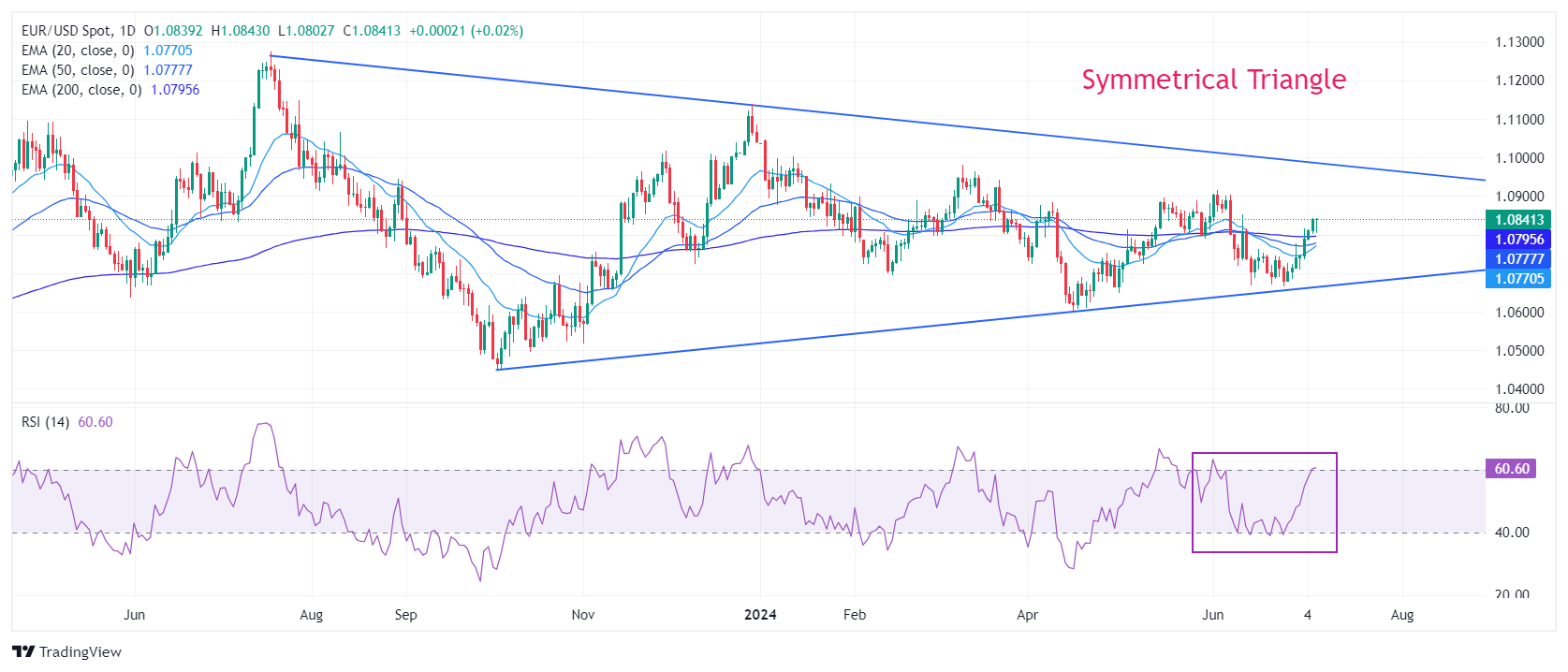- EUR/USD shows strength as growing speculation of Fed rate cuts in September weighs on the US Dollar.
- US labor market conditions appear to have lost momentum.
- The left’s unexpected gains in the French elections have increased uncertainty about the economy’s fiscal outlook.
EUR/USD is stabilising above the 1.0800 round-level support in the European session on Monday. The major currency pair is holding firm as the US Dollar (USD) is under pressure due to growing speculation that the Federal Reserve (Fed) will start lowering interest rates at the September meeting.
The US Dollar Index (DXY), which tracks the value of the greenback against six major currencies, is holding near a three-week low around 104.85.
Market expectations for Fed interest rate cut bets in September have risen further amid evidence that the US labor market is losing momentum. The US Nonfarm Payrolls (NFP) report for June signaled a slowdown in labor demand as revised estimates showed that the number of people hired in April and May was 110,000 lower than previously estimated. Moreover, the Unemployment Rate surprisingly rose to 4.1% from the consensus and the previous release of 4.0%.
In addition, upside risks to inflation are reduced as wage growth momentum appears to have slowed in June. The US NFP report showed that Average Hourly Earnings, a measure of wage growth, declined as expected on a monthly and annual basis.
Fading labor market strength is boosting bets on early Fed rate cuts. According to the CME FedWatch tool, 30-day federal funds futures price data show the probability of rate cuts in September has risen to 75.8% from 64% a week ago.
Looking ahead, investors will focus on the US Consumer Price Index (CPI) report for June, which will be released on Thursday. Investors will pay close attention to inflation to see if the disinflationary process, which stopped in the first quarter, has resumed.
Daily Market Moves Summary: EUR/USD Holds Firm Despite Uncertainty Over Euro Outlook
- EUR/USD clings to gains even though the outlook for the Euro looks uncertain as exit polls show a coalition government set to be formed in the Eurozone’s second-largest economy, France. Polls showed the left, also known as the New Popular Front, led by Jean-Luc Mélenchon, unexpectedly gained the upper hand with President Emmanuel Macron’s centrist alliance and the far-right National Rally party led by Marine Le Pen as runners-up.
- The absence of any party winning an absolute majority has deepened uncertainty over France’s fiscal outlook. This would force the Centrist Alliance into tough negotiations with the Left over the allocation of new ministries and the election of a new Prime Minister. Meanwhile, Jean-Luc Mélenchon has proposed that French Prime Minister Macron should resign and the mandate should be given to the Left to manage the economy.
- On the monetary policy front, rising risks of persistent inflation have dampened expectations that the European Central Bank (ECB) will deliver further rate cuts. ECB officials are scheduled to meet on July 18 to make interest rate decisions.
- The eurozone’s preliminary Harmonised Index of Consumer Prices (HICP) rose steadily by 2.9% year-on-year in June, as services inflation remained persistent at 4.1%. At the ECB Forum on Central Banking in Sintra, Portugal, ECB President Christine Lagarde said: “The disinflationary path is set to continue, but we need to be particularly vigilant in services.”
Technical Analysis: EUR/USD gains firm ground above 1.0800
EUR/USD gains ground above 1.0800. The major currency pair is gaining strength after stabilizing above the 20-day and 50-day Exponential Moving Averages (EMAs), which are trading around 1.0750 and 1.0770, respectively. The overall trend of the shared currency pair has also strengthened as it has jumped above the 200-day EMA, which is trading around 1.0800.
The Symmetrical Triangle formation on the daily time frame exhibits a strong contraction in volatility, indicating low volume and narrow ticks.
The 14-day Relative Strength Index (RSI) reaches 60.00. Will bullish momentum be triggered if it breaks above 60.00?
Euro FAQs
The Euro is the currency of the 20 European Union countries that belong to the Eurozone. It is the second most traded currency in the world, behind the US Dollar. In 2022, it accounted for 31% of all foreign exchange transactions, with an average daily volume of over $2.2 trillion per day. EUR/USD is the most traded currency pair in the world, accounting for an estimated 30% of all transactions, followed by EUR/JPY (4%), EUR/GBP (3%) and EUR/AUD (2%).
The European Central Bank (ECB), based in Frankfurt, Germany, is the reserve bank of the Eurozone. The ECB sets interest rates and manages monetary policy. The ECB’s main mandate is to maintain price stability, which means controlling inflation or stimulating growth. Its main instrument is to raise or lower interest rates. Relatively high interest rates – or the expectation of higher rates – generally benefit the Euro and vice versa. The Governing Council of the ECB takes monetary policy decisions at meetings held eight times a year. Decisions are taken by the heads of the national banks of the Eurozone and six permanent members, including ECB President Christine Lagarde.
Eurozone inflation data, as measured by the Harmonised Index of Consumer Prices (HICP), is an important econometric data point for the euro. If inflation rises more than expected, especially if it exceeds the ECB’s 2% target, the ECB is forced to raise interest rates to bring inflation back under control. Relatively high interest rates compared to their peers usually benefit the euro, as it makes the region more attractive as a place for global investors to park their money.
Data releases measure the health of the economy and can influence the Euro. Indicators such as GDP, manufacturing and services PMIs, employment and consumer sentiment surveys can influence the direction of the single currency. A strong economy is good for the Euro. Not only does it attract more foreign investment, but it can encourage the ECB to raise interest rates, which will directly strengthen the Euro. Conversely, if economic data is weak, the Euro is likely to fall. Economic data from the four largest Eurozone economies (Germany, France, Italy and Spain) are especially significant, as they account for 75% of the Eurozone economy.
Another important output for the euro is the trade balance. This indicator measures the difference between what a country earns from its exports and what it spends on imports during a given period. If a country produces highly sought-after export products, its currency will appreciate due to the additional demand created by foreign buyers who wish to purchase these goods. Therefore, a positive net trade balance strengthens a currency and vice versa for a negative balance.
Source: Fx Street
I am Joshua Winder, a senior-level journalist and editor at World Stock Market. I specialize in covering news related to the stock market and economic trends. With more than 8 years of experience in this field, I have become an expert in financial reporting.








